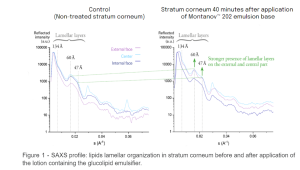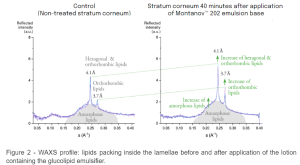
News & Press
X-Ray diffraction technique to characterize the behavior of a sugar-based emulsifier at the skin surface



03 June 2024
The outer layer of the skin (i.e. stratum corneum) is the first protection of our body from external aggressions (irritant substances, Ultra-violet radiations…). Stratum corneum is composed of dead cells (corneocytes) embedded in lipids produced by epidermal cells (i.e.keratinocytes), that can be easily visualized as a “brick and mortar” concept. These intercellular lipids, mainly composed of ceramides, cholesterol and fatty acids are assembled into lipids bilayers predominantly parallel to the skin surface. Within the lamellae, the lipids are arranged laterally in three types of packing from the non-ordered state to the more densely packed: liquid or amorphous, crystalline hexagonal and orthorhombic lipids. Skin barrier function is linked both to the lamellar 3D organization and to the balance between Orthorhombic/Hexagonal/Amorphous lipid states.
Therefore, when applying products to the skin, it is crucial to respect this balance. Altered 3D organization and change in the balance of the distribution of intra-lamellar crystalline hexagonal and orthorhombic lipids, associated with an impaired skin barrier, can lead to skin disorder such as atopic dermatitis. Looking at the effects of chemicals in literature, surfactants were frequently reported to disrupt the skin barrier by disorganizing skin lipids.
This suggested the interest to further investigate what happens to a formulation containing a sugar-based emulsifier after application to the skin; what are the interactions with the stratum corneum?
X-Ray microdiffraction technique provides information on the more or less orderly organization of molecules and their orientation. It was applied to study lipids organization before and after application of a simple lotion containing: 3% of a C20-22 glucolipidic emulsifier, 5% of C8-C10 triglyceride, preservative and water. The x-ray beam was swept from the external face of the stratum corneum to its internal face and microdiffraction profiles were analyzed at small and wide angles (SAXS and WAXS profiles respectively). SAXS profile allowed detection of the presence of lipid bilayers in virgin stratum corneum thanks to typical peaks at around 134 Å, 60 Å and 47 Å. WAXS profile allowed characterization of lipids packing inside the layers: a large signal indicated amorphous lipids; two peaks at 4.1 Å and 3.7 Å signaled crystalline lipids (hexagonal and orthorhombic). The diffraction intensity was proportional to the lipids content.
SAXS profile (Figure 1) showed a stronger diffraction after applying the lotion compared to the virgin stratum corneum, indicating that not only did the emulsion not disturb the lipid organization but it strengthened it.

WAXS profile (Figure 2) after applying the lotion was similar to the virgin stratum corneum indicating the absence of disturbance of the lipids states equilibrium. In addition, increasing intensity of the diffraction at typical peaks, as also seen for SAXS, suggested that formulation lipids gently inserted into the stratum corneum lipids and could reinforce the skin barrier.

X-Ray microdiffraction technique revealed as a useful tool to study the impact of formulated ingredients on organization of stratum corneum lipids. Given the importance of these lipids to maintain skin outer layer in healthy conditions, this technique could be used to evaluate Xylan ingredients coming from Enxylascope project.
Find out more about these studies:
https://www.sofw.com/en/sofw-journal/archive/archive-2/1508-sofw-journal-7-8-2020
Reference:
© Cambos, S.;Roso, A. Positive Impact of Emulsifiers on End-user Skin Benefits. International SOFW Journal 2020,| Volume 146, p28-33 | Thannhausen, Germany, July 31








